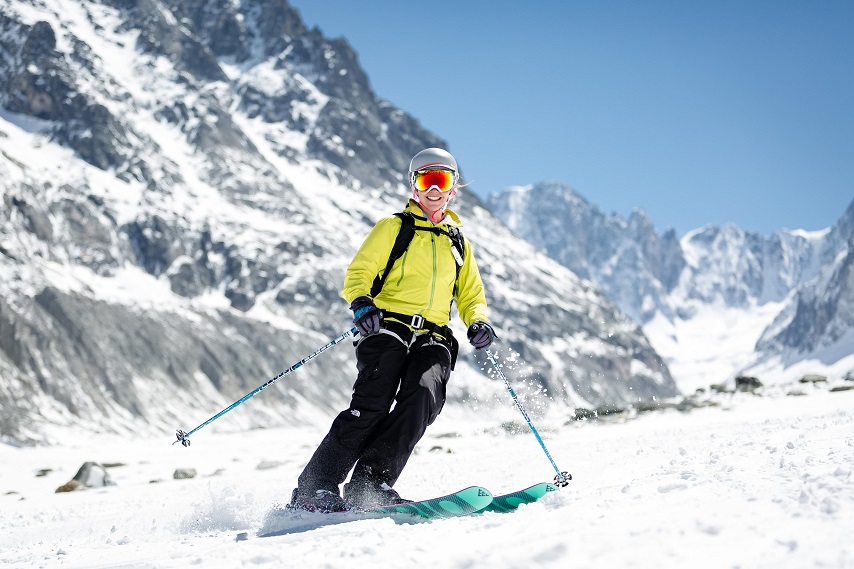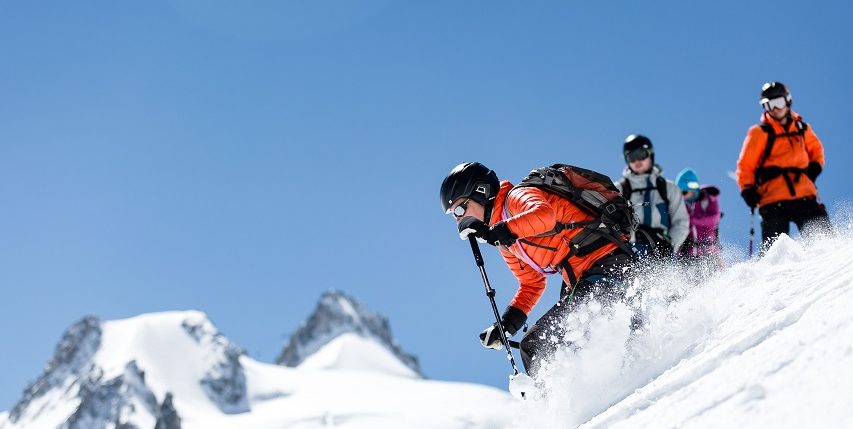Skiing Vallée Blanche, in the Mont Blanc massif (Chamonix), is an outstanding high-altitude off-piste experience. Exceptional in length and beauty, it descends from the top of the Aiguille du Midi, at 3,842m altitude, down to Chamonix 2,800m below.
The Vallée Blanche is most famous for its spectacular glaciated terrain. As such, you need a minimum of knowledge of alpinism and the local environment. You must be well equipped in case of problems, and it’s usual to go with a local guide.
Access for Skiing Vallée Blanche
Aiguille du Midi télépherique
Historically conditions are best to take on this route from January to May depending on the snow cover. To access the starting point at 3,842m you must take two cable cars from the centre of Chamonix to the top of the Aiguille Du Midi.
The cable cars are included on your Chamonix ski pass if you have the full area Mont Blanc Unlimited pass. In high season you can also reserve a cable car in advance at a time to suit your itinerary – usually one of the first few for a full day and fresh lines!
The Aiguille du Midi opening hours are between 7.30am and 4pm for one-way passengers. 3.30pm is the final passage for return cable car journeys. You can check the status here.
What to take
- Duration for skiing Vallée Blanche: from four to six hours all inclusive (usually allow a full day)
- Equipment: avalanche transceiver (beacon), shovel, probe, harness, crampons and crevasse rescue equipment. Your guide will also have a rope for use as you make your way across the arête…
Initiation: the Arête
The ridge that connects the Aiguille du Midi to the Vallée Blanche is a test of nerve ahead of meeting the departure point for your day’s adventures. Consider it your initiation for an adrenaline-packed day!
Not for those with a fear of heights, there is a 150m hike across a ridge line that takes you to a wide platform, which opens directly to the Vallée Blanche.

You can put your vertigo at ease as, once the snow base builds up, you will be faced with a rope to hold onto and a groomed / maintained path about 1m wide (not necessarily level). Crampons are therefore often recommended by your guide, to whom you may be attached as an added security.
Once you reach the natural platform simply strap on your snowboard, or step into your skis. Don’t forget the time for a quick photo! You are surrounded by the breathtaking peaks of the Chaine du Mont Blanc, now closer than ever.
In good company: your guide
The Vallée Blanche is an off-piste, unmarked route which takes place on a glaciated high-mountain terrain. Supervision by a qualified high mountain guide is the safest way to fully enjoy the snow and views. From experience, your guide will choose the best route for your level and share his/her knowledge and history of the surrounding mountains.
Public groups (87€ each – subject to demand) are limited to a maximum of eight people, allowing the guide to provide you with personalised advice and ensure optimal progression. You will also be grouped together, either with other skiers or snowboarders, so that you can take the optimum route for each style.
Alternatively, hire a private guide for approx 380€. This is ideal if you want to try an alternate route, mix skiers and snowboarders, or create a special itinerary to make your ski dreams come true!
Skiing & snowboarding: your level
Skiing the Vallée Blanche should not be your first foray into off-piste skiing, but you don’t have to be an expert either! With different routes for different levels, there is something for all to enjoy as long as you can turn accurately and stop at will in unpredictable off-piste conditions.
You will also need a decent level of both cardio fitness and ski fitness. Not only is there roughly 25km of variable skiing conditions, with almost 3000m of vertical descent, there’s either lengthy stairs or a hefty hike out towards the end – keep reading for more info on that!
It is said that the technical difficulty of the Vallée Blanche (Classique) is similar to that of a red piste. Much like any popular piste in good conditions, there is therefore the potential for moguls to develop. Moguls may slow the rhythm of snowboarders in particular, however skiers should also know how to navigate them with ease.
Snowboarders must also be wary of long flat traverses that may require poles. Meanwhile, skiers must know how to control their speed, side-slip confidently and, naturally, make parallel turns.
Always be aware, this is an off-piste route and the technical difficulty may increase depending on the day’s conditions. Discover the latest Chamonix weather forecast here.
The way down: skiing Vallée Blanche routes

- The Classique: an itinerary adapted to all
This is the easiest route technically and the most “tracked” or travelled line. It follows the slower route in the heart of the great labyrinth of glaciers: the glacier du Géant, the Tacul glacier and the Mer de Glace. Making your way across the arête, and the sometimes delicate passage of seracs of the glacier du Géant before joining the Mer de Glace, constitute the main technical difficulties. - The “True / Vrai Vallée Blanche”: itinerary for good skiers
This historic route is located between the Vallée Blanche Classique and Envers and offers a course in the heart of ice formations. This is a beautiful route famous for spectacular turquoise ice structures between crevasses and small seracs. It requires a good level of skiing due to its constant proximity to crevasses. - The Petit Envers: itinerary for good skiers
A nice alternative to the classic Vallée Blanche, penetrating between the “True Vallée Blanche” and the Envers du Plan glacier. This itinerary is a wonderful option for skiers who want to graduate from the True Vallée Blanche, without being too technical. - The Grand Envers: itineraries for very good skiers
Want to ski steep slopes reserved for very good skiers? This is the route for you with slopes at 45° and the reputation for being the most beautiful route of the valley (as well as the most difficult). Take off from directly from the arête onto the Envers du Plan glacier. This route is technically demanding with a mix of slopes and passages between large seracs.
The final stretch: Montenvers train vs Buvette des Mottets
When the Vallée Blanche is coming to an end your guide will decide between two finishes, based on conditions.
- Either hike out of the Vallée Blanche to join the ski piste that will take you back to Chamonix,
- Or climb the steps to join the Montenvers train which will take back to Chamonix town centre. Your Mont Blanc Unlimited ski pass will give you access to the train.
If in late spring, for example, you can’t ski back down to Chamonix due to snow conditions, you will choose the train. You might also choose the Montenvers train for its history and views after a tiring ski. But remember you’ll still need to take on roughly 400+ steps to reach the cable car, which will link you to the train station.
Alternatively, should there be plenty of snow, after fifteen minutes of steep tiresome hiking you will reach the Buvette des Mottets at 1,638m. Formerly on the edge of the glacier, it is now over a hundred metres away. The hike joining the two skiing sections is increasing each year, as the Mer de Glace retreats.
Once you reach the top you can stop for a drink or picnic with breathtaking views on the west side of the Aiguille des Drus. Then, head down a fun (boardercross-like) forest trail descent back to Chamonix.
NOTE: The ski piste from the Buvette is not groomed but maintained to a certain safety standard. It is quite technical with sharp fast turns that will be difficult after a tiring hike, so take care. You will rejoin the Plarnards ski area next to the Luge track.
Are you ready for skiing Vallée Blanche?
Discover our Chamonix All Year checklist. It has everything you need to know for skiing the Vallée Blanche, the ultimate and unique Chamonix ski experience.



